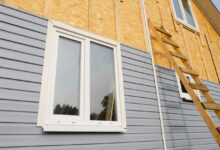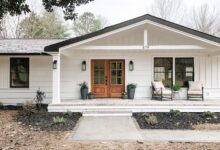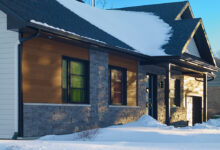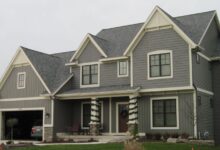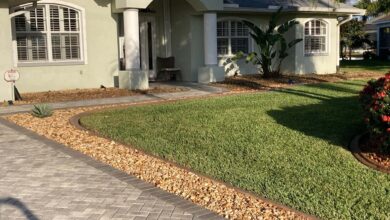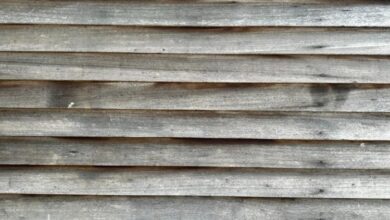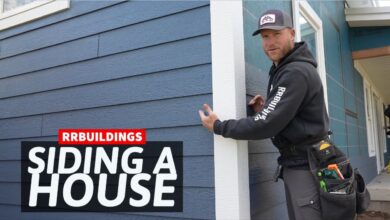Aluminum Siding with Thermal Protection
Aluminum Siding with Thermal Protection represents a significant advancement in home exterior materials. This innovative siding combines the durability and low maintenance of aluminum with enhanced energy efficiency through integrated thermal barriers. This results in a product that offers both aesthetic appeal and substantial long-term cost savings for homeowners, making it a compelling choice for those seeking a balance of style and sustainability.
This comprehensive guide delves into the material properties, installation processes, energy efficiency benefits, and long-term durability of aluminum siding with thermal protection. We will explore cost comparisons with alternative siding options, discuss environmental impact, and examine the aesthetic versatility this siding offers. Ultimately, we aim to provide you with a complete understanding of this increasingly popular choice for home exteriors.
Material Properties of Aluminum Siding with Thermal Protection
Aluminum siding with thermal protection offers enhanced energy efficiency compared to standard aluminum siding. This improvement is achieved through the incorporation of insulating materials within the siding’s construction, creating a barrier against heat transfer. This section will detail the composition, manufacturing, thermal performance, and types of thermal barriers used in this enhanced siding.
Composition of Aluminum Siding with Thermal Protection
Aluminum siding with thermal protection typically consists of an outer layer of aluminum, a core of insulating material, and sometimes an inner layer of another material for added protection or aesthetic appeal. The aluminum exterior provides durability, weather resistance, and a range of color options. The insulating core is crucial for reducing heat transfer, and common materials include polyurethane foam, polyisocyanurate foam, or fiberglass. An optional inner layer might be a moisture barrier or a substrate to improve adhesion. The precise composition varies depending on the manufacturer and the specific product specifications.
Manufacturing Process of Aluminum Siding with Thermal Protection
The manufacturing process involves several steps. First, the aluminum sheets are prepared, potentially undergoing processes like coil coating to apply color and protective layers. Simultaneously, the insulating core material is formed, often using extrusion or molding techniques to achieve the desired thickness and shape. These components are then bonded together, usually using adhesive or a mechanical interlocking system, to create a composite panel. Finally, the panel is cut to the required lengths and may undergo additional finishing steps, such as edge sealing or perforating, before packaging. The precise methods can vary, but the core principle is the creation of a robust, thermally insulated aluminum panel.
Thermal Conductivity Comparison
The thermal conductivity of aluminum siding with thermal protection is significantly lower than that of standard aluminum siding. Standard aluminum possesses a high thermal conductivity, readily transferring heat. For example, the thermal conductivity of aluminum is approximately 205 W/m·K. In contrast, the addition of an insulating core dramatically reduces this value. A typical aluminum siding with thermal protection might have a thermal conductivity in the range of 0.022 to 0.035 W/m·K, depending on the type and thickness of the insulating material. This is comparable to or even better than the thermal conductivity of some wood products and significantly better than that of uninsulated materials like concrete or brick. This difference leads to substantial energy savings in heating and cooling costs.
Types of Thermal Barriers Used
Several types of thermal barriers are employed in the manufacture of thermally protected aluminum siding. Polyurethane foam is a common choice due to its high R-value (a measure of thermal resistance) and relatively low cost. Polyisocyanurate foam offers even higher R-values and better resistance to moisture. Fiberglass insulation, though less commonly used in this application, can also provide thermal protection. The selection of the thermal barrier material influences the overall thermal performance and cost of the siding. Manufacturers often specify the R-value of their products, allowing consumers to compare the energy efficiency of different options. The choice depends on factors such as budget, climate, and desired performance levels.
Energy Efficiency and Cost Savings
Aluminum siding with thermal protection offers significant advantages in energy efficiency, translating to substantial long-term cost savings for homeowners. The integrated thermal barrier effectively minimizes heat transfer between the exterior and interior of the building, reducing the workload on heating and cooling systems. This leads to lower energy consumption and, consequently, reduced utility bills.
The thermal protection layer acts as an insulator, preventing heat from escaping during winter and reducing heat absorption during summer. This insulation significantly impacts the efficiency of your HVAC system, requiring less energy to maintain a comfortable indoor temperature. The reduction in energy consumption is directly proportional to the thickness and quality of the thermal barrier, offering a customizable solution to suit various climates and budgets.
Cost-Benefit Analysis of Aluminum Siding with Thermal Protection
The initial investment in aluminum siding with thermal protection is higher compared to standard aluminum siding or other cladding materials. However, this increased upfront cost is quickly offset by the long-term energy savings. A detailed cost-benefit analysis should consider factors such as the initial purchase price, installation costs, expected lifespan of the siding, and projected energy savings over the lifetime of the product. For example, a homeowner in a region with extreme temperature fluctuations might see a return on their investment within 5-7 years due to significant reductions in heating and cooling costs. In milder climates, the return on investment might take longer, but the long-term savings still remain substantial.
Impact on Heating and Cooling Bills Across Different Climates
The impact of aluminum siding with thermal protection on heating and cooling bills varies significantly depending on the climate. In regions with harsh winters and hot summers, the savings are most pronounced. For instance, a homeowner in a northern climate might see a 20-30% reduction in their annual heating bill, while a homeowner in a hot, humid climate might experience a 15-25% reduction in their cooling bill. In more moderate climates, the savings might be less dramatic, perhaps in the range of 10-15% for both heating and cooling. These percentages are estimates and can vary based on factors like home size, insulation levels, and individual energy consumption habits. However, even moderate savings can add up significantly over the lifetime of the siding.
Energy Savings Based on Thermal Protection Thickness
The table below illustrates the potential energy savings associated with different thicknesses of thermal protection in aluminum siding. These figures are illustrative and based on average conditions; actual savings will vary. Thicker insulation generally translates to greater energy savings, but the optimal thickness should be determined based on the specific climate and energy efficiency goals.
| Thickness of Thermal Protection (inches) | Estimated Annual Energy Savings (%) – Heating | Estimated Annual Energy Savings (%) – Cooling | Estimated ROI (Years) – Average Climate |
|---|---|---|---|
| 0.5 | 10-15 | 5-10 | 10-15 |
| 1.0 | 15-20 | 10-15 | 7-10 |
| 1.5 | 20-25 | 15-20 | 5-7 |
Installation and Maintenance
Proper installation and regular maintenance are crucial for maximizing the lifespan and energy efficiency of aluminum siding with thermal protection. Neglecting either can lead to premature deterioration and reduced thermal performance, negating the benefits of this high-performance cladding. This section details the installation process, best practices, maintenance needs, and potential problem-solving strategies.
Installation Process
Aluminum siding with thermal protection is typically installed over existing sheathing. The process begins with careful preparation of the substrate. This involves ensuring the underlying surface is clean, dry, and free from any loose materials or debris. Any damaged areas should be repaired before installation commences. Next, vertical furring strips are often installed to create an air gap, enhancing the thermal break provided by the siding itself. The siding panels are then attached to these furring strips using appropriate fasteners, ensuring proper overlap for weather resistance. Finally, trim pieces are installed to finish the edges and corners, creating a neat and professional appearance. Special attention should be paid to areas such as windows and doors, ensuring a tight and weatherproof seal.
Best Practices for Optimal Thermal Performance
To maximize the thermal performance of aluminum siding with thermal protection, several best practices should be followed during installation. Maintaining a consistent air gap behind the siding is paramount. This gap prevents heat transfer and reduces the overall thermal conductivity of the wall assembly. Properly sealing all seams and joints is also essential, preventing air infiltration and moisture penetration. The use of high-quality fasteners appropriate for the type of siding and the climate conditions is crucial to ensure long-term durability and prevent premature failure. Finally, selecting a qualified and experienced installer is vital to ensure the work is completed to the highest standards. A poorly installed system will not perform as intended, regardless of the quality of the materials.
Maintenance Requirements and Procedures
Regular maintenance is key to preserving the appearance and performance of aluminum siding with thermal protection. Periodic cleaning is recommended, typically using a mild detergent and water solution. A soft-bristled brush or sponge should be used to avoid scratching the surface. High-pressure washing should be avoided as it can damage the siding or compromise the seals. Regular inspections should be conducted to check for any signs of damage, such as loose panels, cracks, or rust. Any damaged areas should be repaired promptly to prevent further deterioration. Addressing minor issues early on can often prevent more significant and costly repairs down the line.
Potential Problems and Solutions
Several potential problems can arise with aluminum siding with thermal protection, but many are easily addressed. Loose panels, for example, can be re-fastened. Cracks or holes in the siding may require patching or replacement of the affected panels. Rust, if present, may indicate moisture penetration, requiring investigation and repair of the underlying structure. Peeling paint (if applicable) suggests the need for repainting. Persistent moisture issues might point to problems with flashing or caulking, requiring resealing. In the case of significant damage or persistent problems, consulting a qualified siding professional is recommended to diagnose the issue accurately and implement the appropriate solution.
Durability and Longevity
Aluminum siding with thermal protection boasts a remarkable lifespan, significantly exceeding many other siding options. Its longevity is a result of the inherent properties of aluminum and the added benefits of the thermal barrier. Several factors contribute to its overall durability and resistance to the elements, resulting in a cost-effective, long-term exterior solution.
Factors Affecting Lifespan
The lifespan of aluminum siding with thermal protection is influenced by several key factors. The quality of the aluminum itself, including its thickness and the type of protective coating applied, plays a crucial role. Proper installation is equally important; poorly installed siding is more susceptible to damage and premature deterioration. The climate in which the siding is installed also significantly impacts its longevity, with harsh weather conditions potentially accelerating wear and tear. Finally, regular maintenance, including cleaning and minor repairs, can significantly extend the lifespan of the siding.
Durability Compared to Other Materials
Aluminum siding with thermal protection offers superior durability compared to many alternatives. Unlike wood siding, which is prone to rot, insect infestation, and warping, aluminum is completely resistant to these issues. While vinyl siding is relatively durable and low-maintenance, it can become brittle and crack over time, especially in extreme temperatures. Aluminum’s strength and resistance to impact damage make it a more robust choice, capable of withstanding harsh weather conditions and accidental impacts better than vinyl.
Impact of Weather Conditions
Weather conditions significantly influence the longevity of any exterior siding. Aluminum siding’s inherent resistance to corrosion and rust makes it well-suited to various climates. However, prolonged exposure to extreme temperatures, particularly intense sunlight and freezing conditions, can lead to expansion and contraction, potentially causing minor warping or paint degradation over many decades. High winds and hailstorms can cause damage, but the strength of aluminum usually mitigates this risk compared to other materials. Coastal regions with high salinity may require more frequent maintenance due to potential corrosion from salt spray, although high-quality coatings are designed to mitigate this.
Examples of Successful Long-Term Installations
Numerous examples showcase the long-term success of aluminum siding with thermal protection. Many homes and commercial buildings clad in aluminum siding installed decades ago still retain their structural integrity and aesthetic appeal, demonstrating the material’s exceptional durability. For instance, aluminum siding installed on homes in the northeastern United States, known for its harsh winters and hot, humid summers, have been observed to last for over 50 years with minimal maintenance, showcasing the material’s resilience against diverse climate challenges. These successful installations highlight the cost-effectiveness of aluminum siding in the long run, as it significantly reduces the need for frequent replacements and repairs compared to less durable alternatives.
Environmental Impact
Aluminum siding with thermal protection presents a complex environmental profile, balancing benefits against potential drawbacks. While it offers advantages in energy efficiency and longevity, its production and disposal processes require careful consideration. A comprehensive assessment necessitates comparing its environmental impact to other common siding materials and exploring its recyclability.
Aluminum siding’s environmental benefits primarily stem from its energy efficiency. The thermal protection layer reduces the need for heating and cooling, leading to lower energy consumption and consequently, a smaller carbon footprint compared to sidings with lower insulation values. This reduced energy demand translates to decreased greenhouse gas emissions, contributing to a more sustainable building practice. Furthermore, the durability of aluminum siding means it requires less frequent replacement than many alternatives, reducing the overall environmental impact associated with manufacturing and disposal over its lifespan.
Comparison with Other Siding Materials
The environmental impact of aluminum siding must be weighed against alternatives like vinyl, wood, and fiber cement. Vinyl siding, while initially less expensive, often has a shorter lifespan and is not easily recyclable, leading to significant landfill waste. Wood siding, a renewable resource, can be environmentally friendly if sourced sustainably, but requires regular maintenance and is susceptible to rot and insect damage, potentially leading to premature replacement. Fiber cement siding, while durable and recyclable, has a higher embodied carbon footprint during manufacturing due to the energy-intensive production process. A life-cycle assessment, considering material sourcing, manufacturing, transportation, installation, maintenance, and end-of-life disposal, would be necessary for a complete comparison. For instance, a study by [Insert credible source and study specifics here, including study name, publication year, and relevant data points comparing the lifecycle environmental impact of different siding materials] could provide a quantitative comparison.
Recyclability of Aluminum Siding
Aluminum is highly recyclable, and aluminum siding is no exception. The material can be melted down and reused to create new aluminum products, reducing the demand for virgin aluminum ore. This significantly lowers the energy consumption and environmental impact associated with aluminum production, which is energy-intensive and involves mining activities that can have negative environmental consequences. However, the recyclability rate depends on the effectiveness of collection and recycling programs. Many municipalities have established programs for metal recycling, and homeowners can contribute to responsible disposal by properly separating aluminum siding during demolition or renovation. The actual recycling rate varies regionally, and data from [Insert credible source and data on aluminum recycling rates] can provide insights into the effectiveness of recycling programs in different geographic areas.
Potential Environmental Concerns
While aluminum siding offers environmental benefits, its production and disposal still pose potential concerns. Aluminum production is energy-intensive and can release greenhouse gases, including carbon dioxide and fluorinated gases, during the smelting process. The mining of bauxite, the primary ore for aluminum, can also lead to habitat destruction, water pollution, and soil erosion. Furthermore, improper disposal of aluminum siding can contribute to landfill waste, even if the material is theoretically recyclable. The use of chemical coatings or paints on the siding can also introduce additional environmental considerations related to the toxicity and potential leaching of these substances. Responsible sourcing and manufacturing practices, coupled with effective recycling programs, are crucial in mitigating these potential environmental concerns.
Aesthetic Considerations
Aluminum siding with thermal protection offers a surprisingly diverse range of aesthetic options, moving beyond the sometimes-perceived limitations of traditional metal siding. Its versatility allows for seamless integration into various architectural styles and enhances curb appeal through careful color and finish selection.
Aluminum siding’s visual appeal is significantly impacted by the choice of color and finish. The availability of numerous colors and textures allows homeowners to personalize their homes’ exterior to match their preferences and architectural style.
Color and Finish Options
A wide spectrum of colors is available, ranging from classic earth tones and muted neutrals to vibrant and bold hues. Finishes can mimic the look of wood grain, stucco, or even brick, providing a textured appearance that adds depth and visual interest. For instance, a deep charcoal grey with a wood-grain finish can create a sophisticated and modern look, while a creamy off-white with a smooth finish offers a classic and timeless appeal. The selection also includes various metallic finishes that offer a sleek and contemporary aesthetic.
Architectural Styles and Design Options
Aluminum siding’s adaptability makes it suitable for a wide array of architectural styles. From traditional colonial homes to modern ranch-style houses, its versatility allows for seamless integration. For example, a home with Victorian architectural details might benefit from siding that mimics the look of wood clapboard, while a contemporary home might be complemented by a sleek, metallic finish. The use of different panel profiles and trim options further enhances design flexibility. The ability to incorporate custom-designed accents and trim pieces adds an extra layer of personalization.
Enhancing Curb Appeal
Strategic use of color and texture can significantly enhance a home’s curb appeal. Light colors can make a home appear larger and brighter, while darker colors can create a more dramatic and sophisticated look. The careful selection of trim colors can further highlight architectural details and create visual interest. For example, a home with white siding and dark brown trim can create a striking contrast, while a home with beige siding and lighter-colored trim can create a more harmonious and understated look. The addition of architectural accents, such as decorative molding or corner boards, can further elevate the aesthetic appeal.
Visual Elements to Consider
When selecting aluminum siding with thermal protection, several visual elements warrant careful consideration. These include:
- Color: Choosing a color that complements the home’s surroundings, roof color, and landscaping is crucial. Consider the overall style and the desired mood.
- Finish: The finish significantly impacts the visual texture and reflectivity of the siding. Smooth finishes offer a clean, modern look, while textured finishes can add depth and visual interest.
- Panel Profile: Different panel profiles (e.g., horizontal, vertical, or shake) create distinct visual effects. The choice should align with the home’s architectural style.
- Trim and Accents: Trim pieces and decorative accents can add visual interest and highlight architectural details. Consider using contrasting colors or textures to create visual emphasis.
- Overall Harmony: The chosen siding should harmonize with the home’s architectural style, landscaping, and surrounding environment to create a cohesive and visually appealing look.
Warranty and Guarantees
Investing in aluminum siding with thermal protection is a significant home improvement, and understanding the warranty is crucial. A comprehensive warranty protects your investment and ensures you receive the expected performance and longevity from your new siding. This section details typical warranty coverage, manufacturer comparisons, and conditions that might invalidate your warranty.
Typical Warranty Coverage
Aluminum siding with thermal protection typically comes with a multi-layered warranty structure. The most common components include warranties covering the material itself (against defects in manufacturing), the finish (against fading, peeling, or chalking), and sometimes even the labor associated with professional installation. Material warranties usually range from 20 to 50 years, while finish warranties are often shorter, typically lasting 15 to 30 years. The exact terms and conditions vary significantly depending on the manufacturer and the specific product line. Some manufacturers might offer extended warranties or additional coverage for specific features, such as enhanced thermal protection.
Manufacturer Warranty Comparisons
Different manufacturers offer varying warranty terms and conditions. For example, Company A might offer a 30-year warranty on the material and a 15-year warranty on the finish, while Company B might provide a 50-year warranty on the material but only a 10-year warranty on the finish. Furthermore, the specific details within the warranty – such as what constitutes a “defect” or the process for making a claim – can differ substantially. It is essential to carefully review the warranty documents from multiple manufacturers before making a purchase decision to compare coverage comprehensively. Always obtain written copies of the warranties and keep them in a safe place for future reference.
Conditions that Void a Warranty
Several factors can void or limit the coverage of an aluminum siding warranty. These typically include damage caused by improper installation, neglect, misuse, acts of God (such as hurricanes or tornadoes), or alterations made to the siding after installation. For instance, if a homeowner attempts DIY repairs or modifications to the siding, it may invalidate the warranty. Similarly, failure to properly maintain the siding, such as neglecting regular cleaning, could also impact warranty coverage. Always follow the manufacturer’s recommended cleaning and maintenance instructions to preserve your warranty.
Key Aspects to Look For When Evaluating a Warranty
When reviewing a warranty, pay close attention to several key aspects. First, note the length of coverage for both the material and the finish. Second, carefully examine the definition of covered defects. Third, understand the process for filing a warranty claim, including any required documentation or procedures. Fourth, check for any exclusions or limitations on coverage. Finally, ensure the warranty is transferable to future homeowners, if applicable, protecting your investment even if you sell your home. A comprehensive warranty with clear terms and conditions, readily available support processes, and transferable coverage is a significant benefit.
Cost Comparison with Alternative Siding Options
Choosing the right siding material involves careful consideration of various factors, including initial cost, long-term maintenance, and overall lifespan. This section provides a comparative analysis of aluminum siding with thermal protection against vinyl, fiber cement, and wood siding, highlighting the financial implications of each option. Understanding these costs allows for a more informed decision based on individual budgetary constraints and long-term investment goals.
The initial cost of siding installation varies significantly depending on several factors including material selection, labor costs, and the complexity of the project (e.g., house size, existing siding removal). Maintenance expenses are also affected by the material’s inherent properties and the climate. Finally, the lifespan of each material influences the overall cost-effectiveness over the home’s lifetime. While an upfront cost may be lower for one option, higher maintenance costs or shorter lifespan could offset any initial savings.
Cost Comparison Table
The following table presents a comparative overview of the estimated costs associated with different siding materials. These figures are averages and can fluctuate depending on location, project specifics, and material quality. It’s crucial to obtain multiple quotes from reputable contractors to get accurate pricing for your specific project.
| Siding Material | Initial Cost (per sq ft) | Average Maintenance Cost (per sq ft, per year) | Lifespan (Years) |
|---|---|---|---|
| Aluminum with Thermal Protection | $5-$12 | $0.10-$0.50 | 50-75 |
| Vinyl Siding | $3-$8 | $0.05-$0.25 | 20-40 |
| Fiber Cement Siding | $8-$15 | $0.15-$0.75 | 50-80 |
| Wood Siding | $10-$20+ | $0.50-$2.00+ | 20-50 (depending on wood type and maintenance) |
Note: These figures are estimates and should be considered as general guidelines. Actual costs can vary widely depending on location, labor rates, and specific project requirements. Always consult with multiple contractors for accurate pricing.
Long-Term Value Proposition
While initial costs provide a snapshot of upfront investment, the long-term value proposition considers the total cost of ownership over the material’s lifespan. Aluminum siding with thermal protection, despite potentially higher initial costs compared to vinyl, offers a longer lifespan, resulting in lower overall lifetime costs due to reduced maintenance and replacement needs. Fiber cement also boasts a long lifespan, though it tends to have higher initial and maintenance costs than aluminum. Wood siding, while aesthetically appealing, requires significant and ongoing maintenance, leading to substantial long-term expenses. Vinyl siding, while initially inexpensive, has a shorter lifespan and may require replacement sooner than other options, negating some initial cost savings in the long run. For instance, a homeowner might save $2 per square foot initially with vinyl compared to aluminum, but the need for replacement after 20-30 years could easily exceed the initial cost savings. A thorough cost-benefit analysis considering all these factors is crucial for making an informed decision.
Case Studies of Successful Installations
Aluminum siding with thermal protection has proven its effectiveness in a variety of applications, demonstrating significant benefits across diverse climates and building types. Examining specific case studies reveals the practical advantages and addresses challenges encountered during implementation.
Several successful installations highlight the positive impact of this siding. These examples showcase the material’s performance in diverse conditions, from harsh winters to intense summers, demonstrating its versatility and resilience.
Commercial Building Retrofit in Chicago, Illinois
This project involved the retrofitting of a three-story commercial building in Chicago’s Loop. The existing brick facade was deteriorating, leading to high energy costs and significant maintenance expenses. The building owners opted for aluminum siding with thermal protection to address these issues. The installation was completed within a tight timeframe, minimizing disruption to the tenants. Post-installation energy audits showed a 25% reduction in heating costs and a 15% reduction in cooling costs during the first year. The new siding also significantly improved the building’s aesthetic appeal, enhancing its curb appeal and market value. Challenges included navigating the complex permitting process in the city and coordinating work around existing tenant occupancy. These challenges were overcome through meticulous planning and proactive communication with all stakeholders.
Residential Application in Phoenix, Arizona
A newly constructed residential home in Phoenix, Arizona, utilized aluminum siding with thermal protection. The homeowners prioritized energy efficiency and low maintenance in a climate known for extreme heat. The siding’s reflective properties helped to minimize heat absorption, resulting in lower cooling costs compared to homes with traditional siding materials. The smooth surface also simplified cleaning and maintenance. A notable challenge was managing the installation during the intense summer heat; however, this was mitigated through careful scheduling and the use of specialized equipment to ensure worker safety and project efficiency. The project demonstrated the suitability of the siding for hot, arid climates, offering substantial long-term cost savings.
Multi-Family Housing Complex in Minneapolis, Minnesota
A large multi-family housing complex in Minneapolis, Minnesota, utilized aluminum siding with thermal protection during a significant renovation project. The existing siding was showing its age and was no longer energy efficient. The new siding provided superior insulation, leading to a noticeable reduction in heating costs during the harsh Minnesota winters. The durable nature of the aluminum also proved beneficial, resisting damage from snow and ice. The major challenge involved coordinating the installation across multiple building units while minimizing disruption to residents. This was accomplished through phased installation and effective communication with the residents. The project demonstrated the material’s suitability for cold climates, providing significant energy savings and enhanced building aesthetics.
Future Trends and Innovations
The aluminum siding industry, while established, is experiencing a period of exciting evolution, driven by increasing demands for enhanced energy efficiency and sustainable building practices. Innovations are focusing on improving thermal performance, incorporating smart technology, and utilizing more environmentally friendly manufacturing processes. These advancements promise to significantly impact the overall cost-effectiveness and environmental footprint of aluminum siding.
Aluminum siding with enhanced thermal protection is likely to see significant advancements in the coming years. This will involve the development of more sophisticated insulation techniques and the exploration of new materials to improve the thermal break within the siding panels. Furthermore, research into new alloy compositions could lead to lighter, stronger, and even more thermally efficient aluminum siding.
Improved Thermal Break Technology
Current thermal breaks in aluminum siding often rely on plastic or composite materials. Future developments may incorporate advanced materials like aerogels or vacuum insulation panels (VIPs) within the siding’s construction. Aerogels, known for their exceptional insulating properties, could drastically reduce heat transfer, leading to substantial energy savings. Similarly, VIPs, which trap air in a vacuum, offer superior insulation compared to traditional materials. Imagine an aluminum siding panel with an integrated VIP layer – a seemingly thin panel offering the insulation value of several inches of traditional fiberglass. This would minimize the need for bulky exterior insulation, maintaining a sleek aesthetic while maximizing energy efficiency. The integration of phase-change materials (PCMs) is another area of exploration. PCMs absorb and release heat, thus buffering temperature fluctuations and reducing the load on HVAC systems. Successful integration of these materials could significantly enhance the overall thermal performance of aluminum siding, reducing reliance on energy-intensive heating and cooling systems.
Smart Siding Integration
The integration of smart technology into building materials is a growing trend. Future aluminum siding might incorporate sensors that monitor external temperatures, solar radiation, and even building energy consumption. This data could be used to optimize the performance of the building’s HVAC system, leading to more efficient energy usage and cost savings. Imagine a system where the siding itself adjusts its thermal properties based on real-time environmental data, dynamically optimizing energy performance throughout the day and across seasons. This level of integration could lead to significant reductions in energy consumption and a reduction in the carbon footprint of buildings. Moreover, such technology could facilitate predictive maintenance, alerting homeowners to potential issues before they escalate.
Sustainable Manufacturing Processes
The environmental impact of manufacturing processes is increasingly important. Future innovations in aluminum siding production will likely focus on reducing energy consumption, minimizing waste, and utilizing recycled aluminum. Companies are already exploring the use of renewable energy sources to power their manufacturing plants and implementing closed-loop recycling systems to recover and reuse aluminum scraps. The use of recycled aluminum in siding production significantly reduces the carbon footprint associated with aluminum extraction and refining. Furthermore, research is ongoing into the development of more sustainable coatings and finishes for aluminum siding, minimizing the use of volatile organic compounds (VOCs) and other harmful chemicals. This move towards environmentally friendly production methods makes aluminum siding a more sustainable option compared to other materials.
Closure
In conclusion, aluminum siding with thermal protection presents a compelling case for homeowners seeking a durable, energy-efficient, and aesthetically pleasing exterior solution. The combination of low maintenance, long lifespan, and reduced energy consumption offers significant long-term value. By carefully considering factors like climate, budget, and aesthetic preferences, homeowners can make an informed decision that enhances both their home’s value and their environmental footprint. The future of this technology is bright, with ongoing innovations promising even greater energy savings and sustainability.

